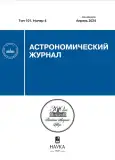Методика оценки количества частиц реголита в пылевом облаке в разряде, инициированном излучением гиротрона
- Авторы: Соколов А.С.1, Гаянова Т.Э.1, Козак А.К.1, Малахов Д.В.1, Нугаев И.Р.1, Харлачев Д.Е.1, Степахин В.Д.1
-
Учреждения:
- Институт общей физики им. А. М. Прохорова Российской академии наук
- Выпуск: Том 101, № 4 (2024)
- Страницы: 348-354
- Раздел: СТАТЬИ
- Статья опубликована: 08.10.2024
- URL: https://pediatria.orscience.ru/0004-6299/article/view/647608
- DOI: https://doi.org/10.31857/S0004629924040053
- EDN: https://elibrary.ru/KFPXTF
- ID: 647608
Цитировать
Полный текст
Аннотация
В статье предложен новый метод оценки количества частиц в экспериментах по моделированию взаимодействия космической и лунной пыли с поверхностью космических аппаратов. Эксперименты основаны на создании пылевого плазменного облака при воздействии излучения мощного импульсного гиротрона на вещество, имитирующее космическую или лунную пыль. Этот подход был опробован с использованием имитатора лунного реголита. Анализ динамики частиц в пылевых облаках, полученных в результате микроволнового разряда, производится с помощью программы ImageJ.
Ключевые слова
Полный текст
Об авторах
А. С. Соколов
Институт общей физики им. А. М. Прохорова Российской академии наук
Автор, ответственный за переписку.
Email: dmc63@yandex.ru
Россия, Москва
Т. Э. Гаянова
Институт общей физики им. А. М. Прохорова Российской академии наук
Email: dmc63@yandex.ru
Россия, Москва
А. К. Козак
Институт общей физики им. А. М. Прохорова Российской академии наук
Email: dmc63@yandex.ru
Россия, Москва
Д. В. Малахов
Институт общей физики им. А. М. Прохорова Российской академии наук
Email: dmc63@yandex.ru
Россия, Москва
И. Р. Нугаев
Институт общей физики им. А. М. Прохорова Российской академии наук
Email: dmc63@yandex.ru
Россия, Москва
Д. Е. Харлачев
Институт общей физики им. А. М. Прохорова Российской академии наук
Email: dmc63@yandex.ru
Россия, Москва
В. Д. Степахин
Институт общей физики им. А. М. Прохорова Российской академии наук
Email: dmc63@yandex.ru
Россия, Москва
Список литературы
- T. E. Gayanova, E. V. Voronova, S. V. Kuznetsov, E. A. Obraztsova, N.N. Skvortsova, A. S. Sokolov, I. R. Nugaev and V.D. Stepakhin, High Energy Chem. 57, 1, 53 (2023).
- N. S. Akhmadullina, N. N. Skvortsova, E. A. Obraztsova, V. D. Stepakhin et al., Chem. Phys. 516, 63 (2019).
- S. I. Popel, L. M. Zelenyi, A. P. Golub and A. Yu. Dubinskii, Planet. Space Sci. 156, 71 (2018).
- И. А. Кузнецов, А. В. Захаров, Л. М. Зеленый, С. И. Попель и др., Астрон. журн. 100, 1, 41 (2023).
- S. I. Popel, A. P. Golub’, A. V. Zakharov, and L. M. Zelenyi, Plasma Phys. Rep. 46 (3), 265 (2020).
- J. Williams, Journal of Plasma Physics 82(03) (2016).
- Y. Zeng, Zh. Ma, Y. Feng, Review of Scientific Instruments, 93 (3) (2022).
- Н. Н. Скворцова, В. Д. Степахин, Д. В. Малахов, Л. В. Колик, Е. М. Кончеков, Е. А. Образцова, А. С. Соколов, А. А. Сорокин, Н. К. Харчев и О. Н. Шишилов, Патент №2727958 Российская Федерация, рег. 28 июля 2020 г.
- Г. М. Батанов, Н. К. Бережецкая, В. Д. Борзосеков, Л. В. Колики др., Успехи прикладной физики 1, 5, 564 (2013).
- А. С. Соколов, Д. В. Малахов и Н.Н. Скворцова, Инженерная физика 11, 3 (2018).
- М. В. Тригуб, Д. В. Малахов, В. Д. Степахин, Г. С. Евтушенко, Д. А. Балабанов и Н. Н. Скворцова, Оптика атмосферы и океана 33, 3, 199 (2020).
- А. А. Летунов, Н. Н. Скворцова, И. Г. Рябикина, Г. М. Батанов, и др., Инженерная физика 10, 36 (2013).
- E.V. Voronova, A. V. Knyazev, A. A. Letunov, V. P. Logvinenko, N. N. Skvortsova, and V. D. Stepakhin, Physics of Atomic Nuclei. 84, 1761 (2021).
- ImageJ Independent Platform, https://imagej.nih.gov/ij/
Дополнительные файлы


















